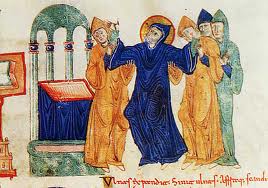 I saw a swallow today, but they move pretty fast and wasn’t able to get a photo. I’ll try again later.
I saw a swallow today, but they move pretty fast and wasn’t able to get a photo. I’ll try again later.
The sighting of a swallow at the turn of the time from winter to spring is particularly auspicious.
(Get the pun? Get it? Huh?).
In celebration of my swallow sighting, I turned to my handy copy of the 2005 Roman Martyrology where today we find the rather laconic entry:
5. In Monte Casino, natalis sancti Benedicti, abbatis, cuius memoria agitur die undecima iulii.
Today marks the “birthday” into heaven of St. Benedict of Nursia (modern Norcia), whose influence in Western Civilization was monumental.
In the traditional calendar in the calendars of monastic communities we celebrate St. Benedict today. In the post-Vatican II calendar, the feast was moved to 11 July. Why? No idea. I am ever impressed by the chutzpa of the reformers of things after Vatican II. Infected with tinkeritis, they imposed on the Church massive innovations to the calendar, eliminating octaves, moving feasts which marked the passing of seasons, the times to plant and harvest, celebrate the heavenly patrons of cities and individuals.
Now they old Italian proverb about the coming of spring hardly makes sense to those who don’t know the old calendar: “San Benedetto, rondine sul tetto…. St. Benedict, a swallow is on the roof”, harking to the fact that this is when swallows are migrating back to Italy. Thus, I come full circle.
In any event, today is the Transitus Sancti Benedicti. I think for the sake of the entry we can leave aside some question of whether a man named “Benedictus” was really our guy or not, for he is rather thinly attested in ancient sources and the Rule isn’t as original as some would have it, we will nevertheless today stipulate that he did live and have a rule and go with it! And if he lived, he died.
We have something about his death from the Dialogues of St Gregory the Great (Book II, 37):
In the year that was to be his last, the man of God foretold the day of his holy death to a number of his disciples. In mentioning it to some who were with him in the monastery, he bound them to strict secrecy. Some others, however, who were stationed elsewhere he only informed of the special sign they would receive at the time of his death.
Six days before he died, he gave orders for his tomb to be opened. Almost immediately he was seized with a violent fever that rapidly wasted his remaining energy. Each day his condition grew worse until finally, on the sixth day, he had his disciples carry him into the chapel where he received the Body and Blood of our Lord to gain strength for his approaching end. Then, supporting his weakend body on the arms of his brethren, he stood with his hands raised to heaven and, as he prayed, breathed his last.
That day two monks, one of them at the monastery, the other some distance away, received the very same revelation. They both saw a magnificent road covered with rich carpeting and glittering with thousands of lights. From his monastery it stretched eastward in a straight line until it reached up into heaven. And there in the brightness stood a man of majestic appearance, who asked them, “Do you know who passed this way?”
“No,” they replied.
“This,” he told them, “is the road taken by blessed Benedict, the Lord’s beloved, when he went to heaven.”
Thus, while the brethren who were with Benedict witnessed his death, those who were absent knew about it through the sign he had promised them. His body was laid to rest in the Chapel of St. John the Baptist, which he had built to replace the altar of Apollo.”
Hagiography, to be sure. But it is a good Memento mori for us all.
In any event, if you want to listen to Lauds, sung in Gregorian chant by the Benedictines in Benedict’s birthplace, Norcia, check out their website HERE. Lauds is HERE.
In any event, today is the feast of the “dies natalis“, birthday into heaven, of St. Benedict.
I wish all Benedictines and all those named Benedict in any way a holy and happy feast wihth many blessings.

































At Citeaux, the ‘Nursery of Saints’ medieval records gave much daily and detailed notation of
the coming and going of birds. If Father Z lived then, it would have been his department.
“At Citeaux Abbey there are many storks which the brothers allow to nest everywhere, for they free the place of reptiles. At winter’s onset, the storks migrate, first circling the monks in the fields to ask their blessing and only once it is given, do they fly away.”
– Kenelm Digby, MORES CATHOLICI Vol. 4, Pg. 424
Was it an African or a European Swallow?
This story about St. Benedict’s birthday into heaven just deepens the richness and color of the tapestry that is the Church. Nothing can compare to belonging.
Maybe spring fever (or too much dark news or hawks swooping over yard [poor old Princess kitty w/booboo paw]) but I miss the pun – auspicious because season change has a sign of ‘normal’? or swallows return to Italy where ChurchHQ has its Springtime, or your sighting means springtime for the work of your apostolate?
Well, no more brainstrain – I second the wish for a good feast day for Benedicts, especially my Pastor and Pope.
In the post-Vatican II calendar, the feast was moved to 11 July. Why?
Apparently, July 11 was the date of the transfer of his remains. According the legend in the Liturgy of the Hours, his memorial has been celebrated on this date in some areas since the 8th century. Allegedly, it was moved to this date on the (new) general Roman calendar to avoid Benedict’s memorial being impeded by Lent. The 1962 Mass of today is that of Wednesday in the 4th week of Lent, with St. Benedict only commemorated with second collects.
“The sighting of a swallow at the turn of the time from winter to spring is particularly auspicious.”
“This… is an a’spicious day. I think we all know what day it is…”
It was so much fun
To decipher the pun
But we tried in vain
With nothing to gain
“Don’t give up your day job” My husband said
As we rattled our brain until it went dead
Ad jucundum:
Temporibus antiquis templo Jovi, haruspex pontifici quaesivit, “Etiam, quod sum, hepatis moretum?”
Salutationes omnibus.
“The sighting of a swallow at the turn of the time from winter to spring is particularly auspicious.
(Get the pun? Get it? Huh?).”
Yes, it certainly augurs well for a good summer!
There aren’t really people who claim that St. Benedict didn’t exist, are there? Do these people think anyone actually lived before the 11th century? [Yes, there are and, yes, they do.]
The sighting of a swallow at the turn of the time from winter to spring is particularly auspicious.
(Get the pun? Get it? Huh?).
Teneo. Quia, “auspex” (deorum consultor) dicitur ab “avibus aspiciendis.” Mos enim erat romanorum ventura coniicere quodammodo ex avium aspectu.
Thank you for this post, Fr. Z.
When I entered the Church at Easter Vigil 2008, I took the name of Benedict. Not only was my discovery of the Rule one waymark on the road to Rome, but I was, for some strange reason, thrilled when I heard that Cardinal Ratzinger had taken the Name of Benedict. He has seemed to be ‘my’ pope from the start.
Great post and thanks for it, Fr. Z!